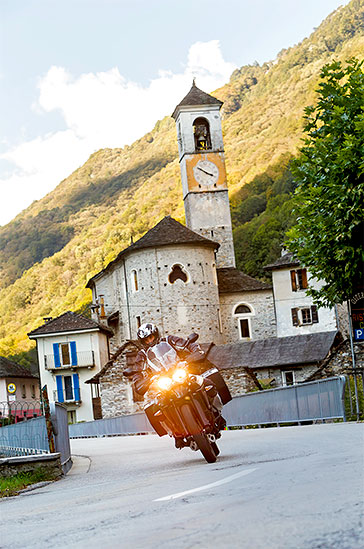Motorcycle tours in the Canton of Ticino: touring tips
Around the lakes and over the mountains


Touring tips
The surrounding region, known as the Mendrisiotto (11) region also offers an enormous range of different attractions. One place well worth a visit is the Baptistry in Riva San Vitale. This baptistry is over 1,500 years old, making it the oldest Christian building in Switzerland. A visit to the baptistry can be combined perfectly with a tour around Monte San Giorgio, staying close to the water's edge the whole time. Monte San Giorgio itself will provide you with an insight into the even more distant past. This mountain is a treasure trove for fossils from the Middle Triassic period, and has therefore been designated a UNESCO World Heritage Site. A visit to the fossil museum in Meride is quite fascinating.
Bends? Yes, the roads in the Mendrisiotto (11) region also have bends. And some fascinating scenery, too: the Muggio Valley gives you the opportunity to enjoy both aspects. Here, the River Breggia has cut out an impressive gorge in the hilly landscape. Idyllic mountain villages are interspersed with chestnut forests, vineyards and Alpine meadows.


- Top image: Alpe di Neggia: One of the most amazing sequences of bends in Ticino. © Jörg Künstle

Away from the cities the whole of Ticino is full of small, often hard-to-find minor mountain passes. One of these starts to the south of Lugano (10) in the aptly-named suburb of Paradiso. This little road starts by climbing steeply before running parallel to the lake shore through Carona, then dropping down through Morcote and back to the lake. Incidentally, this is where some of this year's photos for Louis were taken. On the other side of the peninsula, in Montagnola, the famous author Hermann Hesse lived from 1919 until his death in 1962. There is also a museum there dedicated to Hesse.
Just a few kilometres away from the bustle of the lakeside, to the north of Lugano (10), you will be entering a totally different world: the Malcantone region. This is the ultimate, idyllic Alpine foothill region with small mountain villages made up of typical Ticino stone cottages known as "rustici", vineyards, meadows, forests, and in particular the old chestnut groves, because for a long time chestnuts were an important staple food in Ticino. The climb up from Gravesano comprises 19 bends in succession, so some previous experience of biking in the mountains would not harm.
If you can't get enough of riding on roads with extreme bends, the Alpe di Neggia road is a must! This small, narrow road starts in Vira on Lake Maggiore and ends in Italy, or to be more precise in Maccagno, also on Lake Maggiore. It affords some stunning views over the lake. Roughly half way along this road you will cross the Swiss/Italian border. With its summit at just below 1400 metres, it is far lower than the passes in the high Alpine region, but the height difference of 1200 metres is still very impressive. If you want to combine cornering fun with some motorcycle history, then a detour into the neighbouring region of Italy is a must. Just a few kilometres east of the border lies Lake Como. The shore of Lake Como is home to one of Italy's most prestigious motorcycle marques: Moto Guzzi. You can take a free guided tour round the factory museum in Mandello del Lario. You will find details of opening times on the Moto Guzzi website.
Ticino for when you park your bike up
Information on all aspects of travelling in Ticino.
Motorcycle trips in the Canton of Ticino
The ideal roundtrip for motorcycle fans willing to discover the Ticino on two wheels. The castles of Bellinzona and the mountain Monte San Giorgio (both UNESCO world heritage sites), the lake promenade in Ascona and the panoramic peak of mountain Monte Brè are just some highlights of this tour through the Italian part of Switzerland.
Maps 1
1 Maps note
To ensure you are able to try out our touring suggestions for yourself, the gpx downloads provided here offer a large number of intermediate destinations. This means they have a high data volume and cannot be directly represented on every sat nav system. To modify this, you can import these gpx files into the routing program suitable for your sat nav, and then divide them into portions digestible for the device. The final file size is then dependent upon the sat nav model and the accompanying software version. If you do not have routing software, this file can also be edited in the standard online routing systems. They offer the appropriate conversion tools for virtually all devices on the market.





